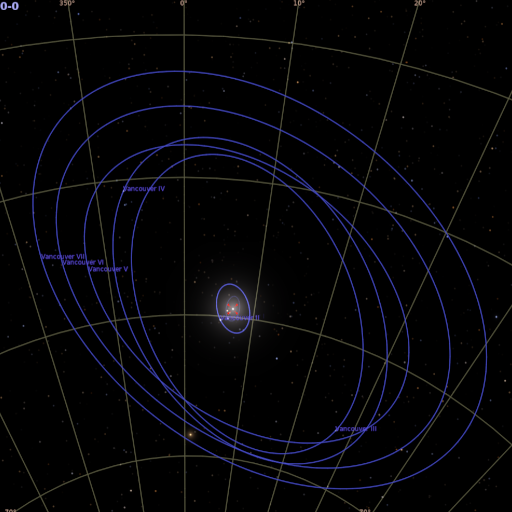System Overview
The Vancouver System, located in the British Columbia Sector Overview A Sector, commonly referred to as a Provincial Sector, is a designated area of space within the broader and diverse cosmic region known as the Canadian Expanse. These Sectors function similarly to provinces, contributing to the organization and governance of this vast territory. Structure and Division The Canadian Expanse is divided into thirteen Provincial Sectors, each with its own... More, is a dynamic and diverse star system comprising seven planets. The system’s primary star, Vancouver Prime, is a G-type main-sequence star (Yellow Dwarf), providing a stable environment for its planets. Vancouver Prime (Vancouver III) is notable for its habitable conditions and the presence of its moon, The Capilano Forest Moon.
Overview A Sector, commonly referred to as a Provincial Sector, is a designated area of space within the broader and diverse cosmic region known as the Canadian Expanse. These Sectors function similarly to provinces, contributing to the organization and governance of this vast territory. Structure and Division The Canadian Expanse is divided into thirteen Provincial Sectors, each with its own... More, is a dynamic and diverse star system comprising seven planets. The system’s primary star, Vancouver Prime, is a G-type main-sequence star (Yellow Dwarf), providing a stable environment for its planets. Vancouver Prime (Vancouver III) is notable for its habitable conditions and the presence of its moon, The Capilano Forest Moon.
Astrophysical Characteristics
Vancouver Prime is a G-type main-sequence star, similar to our Sun, with an estimated age of 5 billion years. The system is situated approximately 360 light-years from Earth. It includes two habitable planets, Vancouver Prime (Vancouver III) and Vancouver Beta (Vancouver V), known for their rich biodiversity and temperate climates. A special feature of the system is The Capilano Forest Moon, which orbits Vancouver Prime.
Planets and Major Bodies
Vancouver I (Fraser):
The first planet in the Vancouver System, Vancouver I is a small, rocky world with a thin atmosphere. Its proximity to the Vancouver System’s star, makes it inhospitable to life.
Vancouver II: (Richmond)
Positioned second in the system, Vancouver II is a desert planet characterized by vast sand dunes and extreme temperatures. Water is scarce, and life is limited to hardy, adapted species.
Vancouver III (Vancouver Prime):
The third planet and the primary habitable world in the system, Vancouver Prime boasts a temperate climate and rich biodiversity. It is known for its diverse ecosystems, lush forests, and vibrant cities.
Vancouver Prime’s Moon (The Capilano Forest Moon):
Orbiting Vancouver Prime, The Capilano Forest Moon is covered in dense, ancient forests and is renowned for its unique flora and fauna. It is a popular destination for researchers and eco-tourists.
Vancouver IV (Bowen):
The fourth planet, Vancouver IV, is an ocean world characterized by its extensive bodies of water and numerous islands. It is a hub for marine research and exploration.
Vancouver V (Vancouver Beta):
The fifth planet, Vancouver V, is another habitable world with lush forests and diverse ecosystems. It is noted for its scenic beauty and thriving wildlife.
Vancouver VI (Capilano):
The sixth planet, Vancouver VI, is a massive gas giant with vibrant cloud formations and multiple moons. It is a prominent feature in the system’s night sky.
Vancouver VII (Squamish):
The seventh planet, Vancouver VII, is an ice planet with a frigid climate and extensive glaciers. It is known for its stunning, snow-covered landscapes.
Historical and Cultural Significance
The Vancouver System has a rich history of exploration and settlement, with a strong cultural heritage rooted in both human and indigenous traditions. The system is known for its preservation of ancient ruins and cultural landmarks, particularly on Vancouver Prime and The Capilano Forest Moon.
Inhabitants:
– A diverse population including humans and various indigenous species.
Current Status
Governance:
The Vancouver System is governed by a coalition council representing all major species and settlements, ensuring a balanced and inclusive approach to leadership.
Economic Activities:
Major economic activities include tourism, agriculture, marine research, and forestry. The system’s unique biodiversity and natural beauty attract visitors and researchers alike.
Major Settlements:
Key settlements include Vancouver City (capital), Capilano, and Whistler.
Strategic Importance:
The system is a key hub for trade, cultural exchange, and scientific research within the British Columbia Sector Overview A Sector, commonly referred to as a Provincial Sector, is a designated area of space within the broader and diverse cosmic region known as the Canadian Expanse. These Sectors function similarly to provinces, contributing to the organization and governance of this vast territory. Structure and Division The Canadian Expanse is divided into thirteen Provincial Sectors, each with its own... More.
Overview A Sector, commonly referred to as a Provincial Sector, is a designated area of space within the broader and diverse cosmic region known as the Canadian Expanse. These Sectors function similarly to provinces, contributing to the organization and governance of this vast territory. Structure and Division The Canadian Expanse is divided into thirteen Provincial Sectors, each with its own... More.
Notable Locations
Vancouver City:
The bustling capital city, known for its markets, cultural institutions, and government buildings.
The Capilano Forest Moon:
A unique moon covered in dense forests, renowned for its biodiversity and ecological research facilities.
Whistler:
A major settlement on Vancouver II, known for its harsh desert environment and mining operations.
Bowen Oceanic Institute:
A leading research facility dedicated to studying the marine life and ecosystems of Vancouver IV.
Exploration and Research
Exploration History:
The Vancouver System was initially explored by early settlers, followed by systematic exploration and mapping by scientific expeditions.
Ongoing Research:
Current research focuses on biodiversity, sustainable development, and the preservation of ancient cultural sites.
Important Discoveries:
Significant discoveries include ancient ruins on The Capilano Forest Moon and new species of marine life on Vancouver IV.

